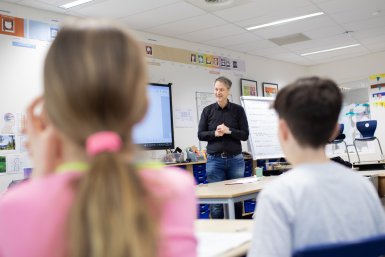Utrecht University: Science Professors Make Visits to Elementary Schools
Along with 104 other Professors from Utrecht University, computational biologist Kirsten ten Tusscher and experimental physicist Raimond Snellings visited elementary schools today. In this way, they introduced the students to science and engaged them in conducting research. They did this as part of Meet the Professor, an annual event organised by the Center for Science and Culture at Utrecht University.
Showing and learning how plants decide
Theoretical biologist Kirsten ten Tusscher is one of the professors from the Faculty of Science who participated in Meet the Professor. She looks back fondly on her visit to the Public Elementary School (OBS) Overvecht, along with her team member Lucila Salvatore.
The researchers immersed the children in the world of plant biology. They challenged them to think about how plants can make decisions, whether plants have a memory, and how they spend their energy. By using carnivorous plants and petri dishes with germinating plants, they made the discussions lively and tangible. Along the way, they also found an opportunity to explain how science works, and how experiments can provide evidence for an idea or claim.
It’s amazing to see how the children react and what questions they ask
“It’s amazing to see how the children react and what questions they ask,” says Ten Tusscher. “So many things in my research have become obvious to me, but to them they are new and special.” The children’s amazement actually began when Ten Tusscher entered the classroom – most of them hadn’t expected that ‘their’ professor could also be a woman. “Beforehand, the children were asked to draw a professor, and that mostly resulted in drawings of grey old men.”
Ten Tusscher is pleased that she could not only introduce the children to her field of study but also serve as an example of what a scientist actually is. “I was a first-generation student and now I am a professor,” says the researcher. “It’s fantastic to show that basically anyone could become a professor, also when you’re a woman and didn’t grow up in an academic family.”
The smallest building blocks
Raimond Snellings is Professor of Heavy Ion Physics. He investigates the smallest building blocks of our universe and conducts experiments using the Large Hadron Collider at CERN, the world’s largest particle accelerator. He leads the Dutch contributions to the international ALICE experiment and is scientific director of the Institute of Gravitational and Subatomic Physics at Utrecht University.
Today, he visited combined classes 6/7/8 at Jenaplan School Cleophas in Overvecht. They were particularly well-prepared for his visit. “There were concepts from my field written on the blackboard, and all the students thought of a question,” Snellings says. “It was a fun, active group. Even after an hour and a half, they still had their hands up in the air.” They were very curious, according to Snellings. How did the universe originate? Why did you become a professor? But also: Can religion and science coexist?
It was a fun, active group. Even after an hour and a half, they still had their hands up in the air
Snellings has participated in the event almost every year so far. It’s the perfect opportunity to reach children who may not come into contact with the university as easily, so he thinks. “My career path wasn’t very common, either,” he says. “I enjoy telling that story, and I notice that the students find it interesting to hear.” Another interesting detail: The students didn’t know in advance which professor would be visiting them. They drew a picture of what they thought this scientist would look like. “Almost all of them drew a woman wearing a lab coat. That’s quite different from five years ago!”

